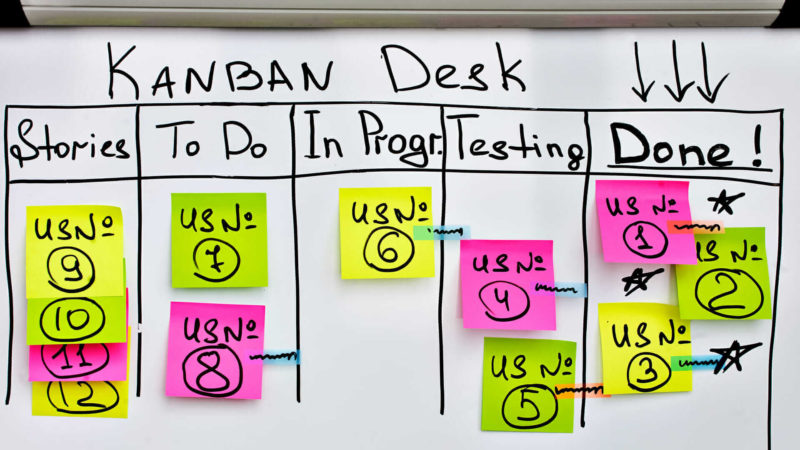
The following is a selection from the e-book “MarTech’s agile marketing for leaders.” Please click the button below to download the full e-book.
To lead an agile marketing organization, you must take a value-based approach. Rather than thinking about how your process will change, think about the values you need to live by and get your teams to live by, and then make day-to-day changes that support those values.
The agile leadership values below will help you understand your role in an agile marketing organization.
Collaborate with your teams to set metrics for success, but leave execution to the teams. Create a dynamic that encourages interactive and not insular problem-solving.
When you were a child, your mom probably picked out your clothes for school, made your lunch, packed your backpack, looked through everything you brought home from school and knew where you were at all times. Your parents controlled everything you did because you didn’t have the emotional maturity to do things on your own in
kindergarten.
By the time you were in high school, while not yet a full-fledged adult, you probably had a lot more responsibility. Your parents could tell you what outcomes they wanted you to achieve such as “Maintain a 3.0 GPA” or “Get accepted into college”. But they (hopefully) didn’t look over your shoulder with every homework assignment or require getting their approval before you wrote an essay. They gave you clearly desired outcomes and trusted you to get the job done.
When I look at companies and how they operate, I find that a lot of leaders are helicopter parents. They want to know what the team is working on at all times, and instead of talking about desired results, they’re focused on tactics and approvals.
I was working with a traditionally-operated bank that was trying to learn agile marketing. However, the micro-management culture ran deep. Work was initiated by stakeholders that felt a lot more like they were going to McDonald’s and placing an order than working with smart, creative and talented people. “Hi, I’d like two travel articles with a social media post on the side. Make sure that it contains no ketchup or mayo and an extra big helping of approvals.”
Get the daily newsletter digital marketers rely on.
As a leader, you have the power to change this behavior. You can turn your staff into consultative marketers that can bring valuable ideas to the table. Start by helping your team to ask the right questions. Instead of blindly accepting every request, encourage them to have a dialogue like this:
Stakeholder: “I need you to send out an email blast to everyone on our mailing list telling them about our new banking app.”
Employee: “What are you trying to achieve?”
Stakeholder: “We need to build up our sales pipeline.”
Employee: “What does a successful pipeline look like to you?”
Stakeholder: “Getting 50 qualified new leads that we can follow-up on.”
Employee: “An email may be one avenue. However, our team has had some recent success with short videos. Can I talk to the team and we can come up with a really great plan on how to achieve 50 qualified new leads?”
When we can have these types of conversations with our stakeholders, we empower our teams to be part of the solution. When the team is part of the solution, a lot of great things happen. You get happier employees, more creative ideas and a team that does more than just take orders. Teams like this really work on the right things at the right time.
Metrics that matter
There are metrics you should ask your teams to provide and others that are not helpful in an agile environment.
When you’re leading a marketing department, it’s important to understand how the team is progressing on a campaign or project timeline; how a campaign is performing and how customers are responding to it; how good the team is at delivering customer-ready work; and how predictable a team is at delivering on its commitments. These metrics are all team-based and revolve around desired outcomes.
Whether you’re using agile marketing or not, the question of when something will be done will always be relevant, and the team should always be transparent about it. A campaign burnup chart is a good visualization for understanding how a team’s work is trending. This is especially important if you have a fixed date by which you must complete the entire campaign. Be careful, however, not to pressure a team into unrealistic timelines or you might end up with skewed metrics that make you happy in the short-term, but will let you down when it’s time for delivery.
Campaign performance should be transparent from the team, but doesn’t need to be a formal metric. Discussions around customer engagement and about whether the campaign is over – or under-performing should take place in real-time and as often as possible.
Customer value and delivery, not volume, need to be at the heart of what you are asking for. Real value happens when work gets to customers and the team can respond with agility. One way to understand whether this is happening from your agile marketing teams is to look at how much work a team takes in, versus how much gets fully completed. In agile marketing, the user stories a team works on are supposed to be about customer value rather than an individual’s task — so a team that gets 10 stories done is actually doing better than a team that got 15 started, but only completed four of them. Most agile software tools will show committed versus completed stories, so this is a great metric to request from your teams.
Some metrics to avoid are:
- Individual contributor utilization — remember agile is all about teamwork to get something of value to customers
- Story point comparisons from team to team (teams point differently and will begin gaming the system to look better)
- How many tasks got completed.
These metrics focus on individual performance and output, the opposite of what we’re trying to achieve with agile marketing. As a leader, helping your employees learn to become equal partners in determining work, and giving them the space and support they need to learn and grow, are essential skills for agile marketing.

Customer engagement, not rigid contracts
Feedback from diverse customers is essential for improvement, and there are always improvement opportunities.
Engagement can come both from internal stakeholders and actual customers, but the idea is that we’ve built enough flexibility into the way we work that feedback can be quickly incorporated into our workflow.
Large organizations are often only taking feedback from the highest-paid person in the room. While that opinion should be valued, it’s imperative that it’s not the only voice that’s heard.
Let’s say the team is reviewing a recent marketing campaign with you and their CMO, and you honestly think the campaign is not hitting the mark. It may be tempting to tell the team everything that’s wrong with it; however, you need to give them the freedom to hear other people’s perspectives. So instead of telling them what’s wrong, consider asking:
- “Can you test a small piece of this in-market?”
- “Can we get the sales team to weigh in?”
- “How does customer service think this may resolve some recent complaints?”
A successful agile marketing team will get feedback from a lot of places, but you need to give them the autonomy to decide what to do with that feedback. Maybe it’s a small tweak? Maybe they scrap the campaign and start from scratch?
The “rigid contracts” piece is another consideration you must think about as a leader. If teams have had to commit to specific deliverables, they are probably running at 110 percent execution mode and don’t have time to stop, accept feedback and make changes.
It’s important that as a leader you offer flexibility in deliverables so teams have time and space to do the right work at the right time.

Explore capabilities from vendors like Adobe Workfront, Wrike, Airtable, Smartsheet and more in the full MarTech Intelligence Report on marketing work management platforms.
Working solutions, not excessive documentation
Find comfort in good enough, and create room for teams to focus on identifying and removing impediments. Offer support to devolving complex problems, and allow the team to iterate and deliver solutions.
Focusing on “good enough” can feel really scary — after all, we’ve been conditioned our whole lives to make sure things are done perfectly. So why does agile marketing say to focus on good enough?
Let me first say, I’ve seen the perfectionist mindset at work, which reminds me of my time as a program manager at a large commercial bank. The bank had a project to remove customers’ full account numbers from their statements to meet compliance requirements. I worked on this one project for nearly a year, and it had started many months before I arrived.
When I left this role, the company was still discussing the requirements of the project. There were hundreds of people and millions of dollars involved, yet nothing was getting done. As a customer of that bank, a year later I checked my statement and nothing had changed.
While this is an extreme example, the point is that waiting for perfection is expensive and customers don’t see any benefits from your internal process. All of that time making something just right on the inside is like a retail store with inventory sitting on the shelves — no one can buy your product!
So as leaders, it’s business-critical to embrace the “good enough” mindset. This isn’t to say you should just work as fast as you can to deliver garbage; instead, help your teams embrace that sweet spot where enough time is spent to get valuable work in the hands of customers.
Here are five ways to embrace the good enough mindset:
- Reduce the number of approvals needed.
- Coach your teams to think about a minimally viable campaign by asking, “What’s the earliestnpoint in time that we can release parts of this campaign?” It doesn’t have to be an all or nothing answer.
- Have your teams create “Definitions of Done.” What things are needed to make a story done, and how can this strike the right balance of quality versus speed? Help teams reduce unnecessary process overhead.
- Strive for work to happen within the teams whenever possible. Every time they have to wait for an expert, inventory sits on the shelf.
- Look for the simplest solution, not always the desired end state. You may be able to create a landing page that meets business goals quickly by compromising a few bells and whistles.
Flexibility, not concrete plans
Look for opportunities to take risks and test hypotheses safely. Continuously review so that you can re-prioritize and stop activities that are not yielding benefits in the required time frames.
This really speaks to the heart of agile marketing. Sure, there are some common practices to learn, but the flexibility to experiment and change gears based on customer feedback is critical, and yet so many marketing organizations miss this opportunity. The first thing you can do as a leader is give your teams permission to be wrong. If your teams feel like all of their marketing has to be spot on, you will lose innovation and probably some really great out-of-the-box ideas.
The next thing that’s needed from you as a leader is to consider the feedback process to be part of the work when teams estimate how long something will take to complete. So when a team is planning, they should be keeping in mind more than just getting the marketing tactic out the door.
They need time to gather results, analyze those results and decide what those results will mean for future work. This requires space and time. If a team is in 110 percent execution mode, which most are, you will simply get output.
I was recently talking to a government agency that has mastered this concept. When they see that a campaign isn’t performing well, the team has the ability to stop it altogether. This may seem like a small thing, but it takes a lot of trust and empowerment to allow the team to make the decision.
It also takes leadership that will respect the team’s decision to not deliver something as expected. However, when you take a step back at the end of the day, is it your marketers’ job to crank out stuff to meet a deadline, or is it to achieve business outcomes? If you can shift your organization’s mindset to the latter, then stopping campaigns that don’t achieve results will seem like a smart thing to do.
Opinions expressed in this article are those of the guest author and not necessarily MarTech. Staff authors are listed here.


![HubSpot's 2025 State of Blogging Report [Data from 500+ Marketers]](https://www.liveseo.com/wp-content/uploads/2025/02/HubSpots-2025-State-of-Blogging-Report-Data-from-500-Marketers.webp-300x300.webp)


